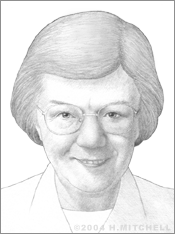Edith Flanigen
Chemist Edith Flanigen was born in Buffalo, New York on January 28, 1929. She received a BA from D'Youville College, where she graduated as class president and valedictorian, and continued her studies at Syracuse University. There, she completed an MS in inorganic physical chemistry in 1952.
She began working that year in Tonawanda, New York, as a research chemist with Union Carbide Corporation and UOP, a joint venture of Union Carbide and AlliedSignal. Her two sisters, Joan and Jane, worked there as well, at a time when women were rarely found working in highly complex scientific careers. Flanigen worked on the identification, extraction, and purification of various silicone polymers, chemical compounds that could then be used in chemical processes.
Four years later, in 1956, Flanigen began working on the developing technology of molecular sieves, crystal compounds that work like strainers at the molecular level. These sieves have pores that can be used to filter and separate components of very complex mixtures. They can also work as catalysts for chemical reactions. The sieves she developed would have a wide range of critical applications in the petroleum and petrochemical refining industries. In particular, her development of the substance known as “zeolite Y” gave the world a sieve that has the ability break crude oil down into parts, a necessary step that allows the various parts to be used commercially. For example, her zeolite Y sieve is able to optimize conversion of crude oil into gasoline. This sieve helps to make oil refining cleaner, safer, and more efficient.
Flanigen has said that one of her strengths throughout her career has been her ability to discover a new material and see it through to commercialization, from envisioning processes for manufacturing it on a large scale to developing it for industrial application. Her sieves are also used in water purification and environmental cleanup and can be used to make ethylene and propylene, which are elements necessary to the manufacturing of some plastics.
In addition to her work on molecular sieves, Flanigen also co-invented a synthetic emerald, which Union Carbide produced and sold for many years. The emeralds were used mainly in masers (predecessors to lasers) and were even used in jewelry for a time, in a line marketed as the “Quintessa Collection.” Flanigen also pioneered the use of mid-infrared spectroscopy for analyzing zeolite structures. In 1982, she became the first woman to hold Union Carbide’s highest technical position – senior corporate research fellow.
She retired in 1994, after earning 108 U.S. patents in the fields of petroleum research and product development.
She has received numerous awards and honors. In 1991, she was awarded the Perkin Medal, the nation’s most distinguished honor in applied chemistry. She was the first woman ever to have received the award. Flanigen was the recipient of the $100,000 Lemelson-MIT Lifetime Achievement Award in 2004 and was inducted into the National Inventors Hall of Fame. On November 20, 2014 President Obama presented Flanigen with the National Medal of Technology and Innovation for her contributions to science.


